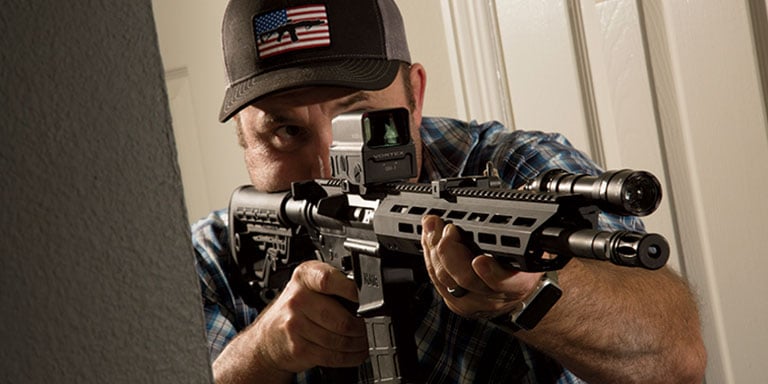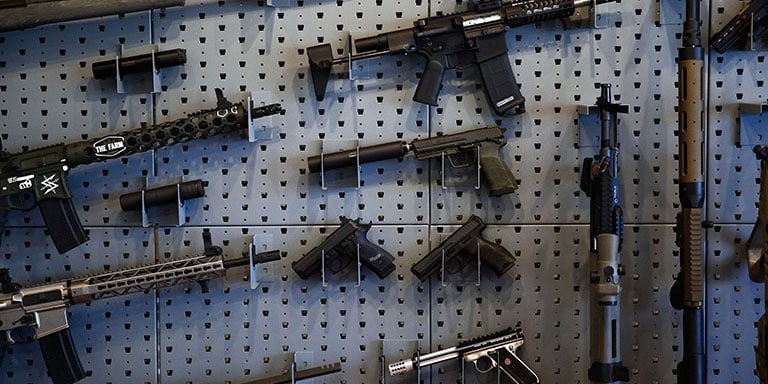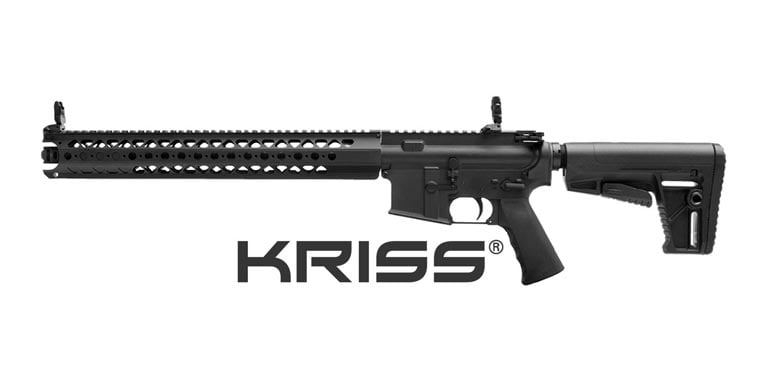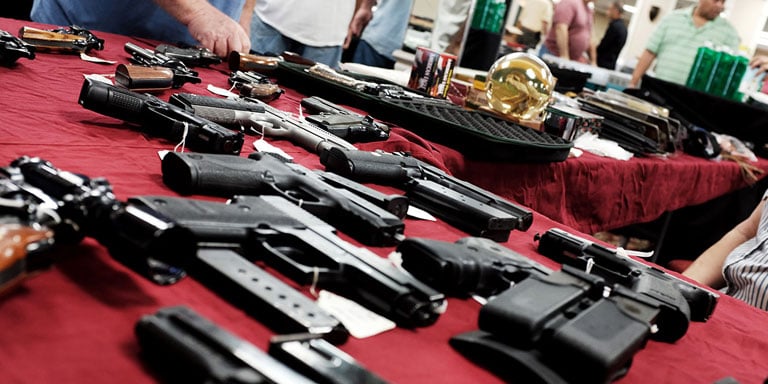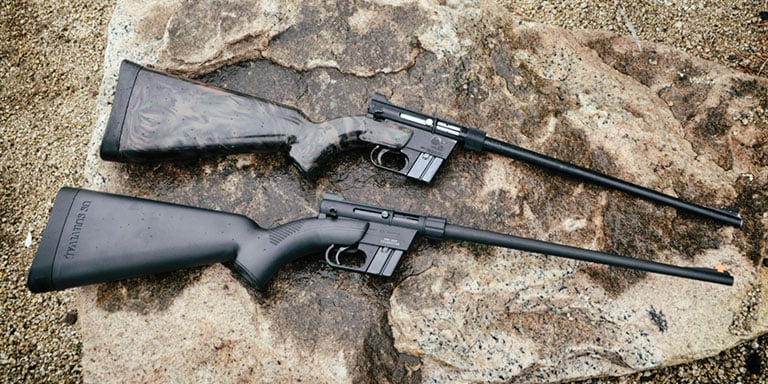
A rifle is one of your most important and versatile tools. It can put food on the table and protect your family. But as any shooter knows, not all rifles are created equal. Each one is designed for a specific purpose, and finding one perfectly suited to your needs can take a while.
In this guide, we'll present a few different interpretations of the term “survival rifle” and go over their uses, pros and cons. We'll also lay out the most important factors to consider when shopping for one and briefly review eight of our favorite models.
What Is a Survival Rifle?
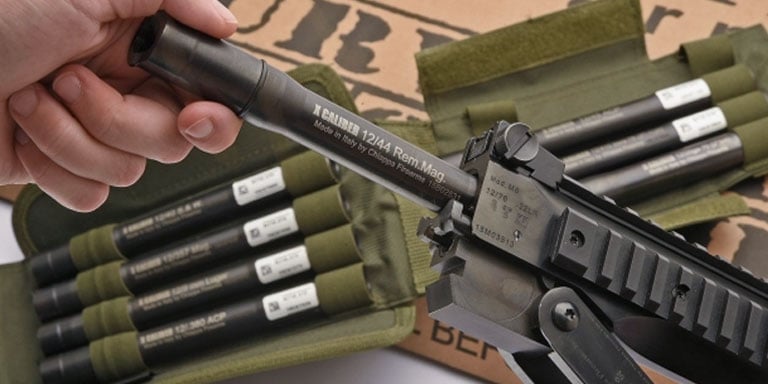
The term “survival rifle” is somewhat ambiguous and means different things to different people. Some believe that the term is applicable only to a specific kind of rifle that is ultra-lightweight and often foldable. Others use the term “survival rifle” to indicate specific kinds of versatility, such as to designate double-barreled rifles that can fire two different kinds of ammunition.
We tend to take the term broadly and literally: a survival rifle is any rifle that helps you survive in an unusually challenging environment or situation. Depending on the nature of that environment or situation, certain features of a survival rifle will be more useful than others. We think that, above all else, a survival rifle should be versatile (that is, capable of performing well in several different scenarios).
Strengths and Weaknesses of Survival Rifles
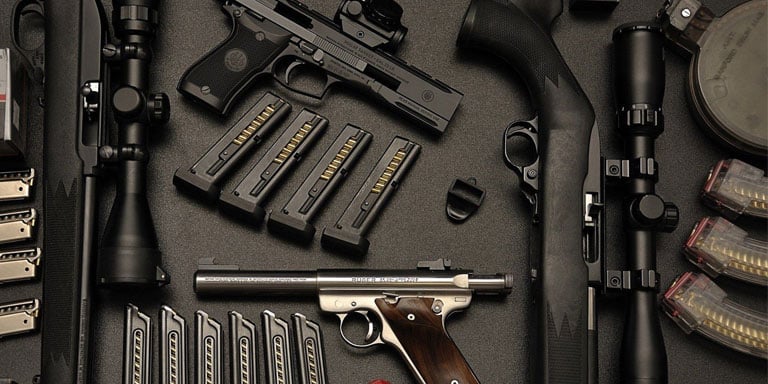
Because the term “survival rifle” is so open to interpretation, it's largely meaningless to say that they all share common pros and cons. Still, most people use rifles for either self-defense or hunting, so we'll evaluate rifles in general relative to those considerations and point out how different kinds of survival rifles might excel (or fall short) in each category.
Self Defense (Long Range)
Rifles are, of course, the weapon of choice for long-range applications. Pistols and shotguns simply can't reliably hit targets beyond about 50 meters, and if they do, the bullet or shot will have lost much of its velocity by then.
Almost any medium or large-caliber rifle is well-suited to self-defense at distances beyond 50 meters. Bolt-action rifles fire slowly, and it's easy to lose sight of a moving target when looking through a scope, but if the enemy is far away, you at least have a little time to line up another shot or reevaluate your options.
Self Defense (Short Range)
At ranges of 10 to 50 meters, a rifle's usefulness as a self-defense weapon becomes more dependent on its features. Rate of fire becomes a prime concern at this distance, particularly for single-shot or bolt-action models; you may only have time for one or two shots before an attacker closes to melee range.
A semi-automatic rifle with a large magazine, a scope and offset iron sights can be an ideal short-range self-defense weapon. Being able to quickly switch between the scope and iron sights makes it much easier to keep track of your target, and you'll want the ability to fire quickly and repeatedly as a point-blank engagement becomes more likely.
Self Defense (Close-quarters combat)
Survival rifles tend to be tactically weakest at ranges less than 10 meters. They can be bulky and slow to maneuver, especially in tight spaces or with several accessories attached to them. Only the most gigantic rifle calibers will consistently incapacitate attackers in a matter of seconds, so even if you land several clean hits on an aggressor at close range, they may still pose a threat for some time.
There are ways to make rifles more effective at CQB range. Take a class that will teach you how to use a rifle as a melee weapon or attach a bayonet (ideally, both). Some double-barreled survival rifles fire shotgun shells (usually only one at a time), but having even a single shotgun shell at your disposal tips the odds in your favor in a CQB encounter.
Many survivalists train and choose equipment based on the assumption that they'll only have a single firearm, usually for weight management reasons. A properly configured survival rifle is effective at any range and can be a great choice if you're looking to travel as light as possible.
Small Game Hunting
Many rifles that are marketed as “survival rifles” are built specifically for small game hunting. They're exceptionally light, mechanically simple and chambered in small calibers. Sufficiently small calibers, such as .22LR, can be virtually silent (especially with a suppressor),and noise discipline is hugely important in survival situations.
In short, almost any survival rifle is a good choice for small game.
Big Game Hunting
Survival rifles are often ill-suited to hunting big game. In order to drop large animals reliably and cleanly, you almost invariably need large bullets, which generally means a bolt-action rifle with a low magazine capacity; two things you want to avoid (or at least compensate for) in a survival rifle.
Medium-caliber, semi-automatic rifles, such as an AR-15 chambered in 5.56, can be acceptable big-game weapons, but therein lies a bit of a catch-22: you'll need to practice a lot in order to be able to humanely kill a big animal with a medium rifle, but hunting with such weapons is illegal in some places (and unethical if you're not an expert marksman). However, some AR-15s and other semi-automatic rifles can be chambered in larger calibers, like .308—a perfectly serviceable round for hunting elk, moose, or smaller bears.
We recommend that you not attempt to hunt big game with a small or medium-caliber rifle unless you find yourself with no better options in a true life-or-death emergency.
Survival Rifle Characteristics
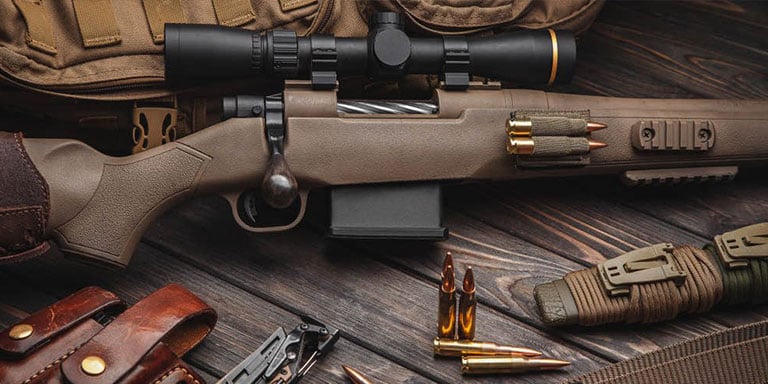
Like any other rifle, survival rifles should be evaluated with respect to the roles you most want them to fill. Your local environment, your firearm expertise and preferences, and the kinds of survival situations you think are most likely will all be relevant factors.
Stopping Power
Virtually every reputable study on the lethality of firearms has confirmed that most attackers aren't stopped instantly unless hit in the brain. Even those shot in the heart can sometimes remain conscious and keep fighting for several minutes.
That being said, there is a mostly linear relationship between caliber and stopping power. Larger bullets stop attackers more quickly and reliably, but they're louder, more expensive and more difficult to shoot. Reduced magazine capacity is also a concern.
Double-barreled survival rifles that fire one small caliber and one large one can offer much more versatility.
Ease of Use
Most rifles marketed as survival rifles are mechanically simple and have few fancy features. This makes them less likely to malfunction and easier to clean; novice shooters will also be able to handle the weapon more confidently. Of course, you can have more bells and whistles on your survival rifle if you choose; just make sure you know how to use them and train regularly.
Capacity
Magazine capacity depends mostly on caliber and is an especially important consideration for survival rifles. Reloading a firearm quickly in the heat of combat is harder than it may seem, and you'll need to train often to keep that skill fresh. If you're not confident in your ability to replace a magazine in under two seconds while under duress, consider a rifle that you don't need to reload as often.
Rate of Fire
If you intend to use your survival rifle primarily for hunting, rate of fire isn't hugely important (just make sure you have a backup self-defense weapon that can fire quickly). But if you want a versatile rifle that can also handle self-defense situations, we strongly recommend a semi-automatic model with a detachable magazine.
Weight, Portability and Concealability
To many survivalists, weight is the most important consideration in choosing a survival rifle. Some models come with lightweight skeleton stocks or are made of ultra-light synthetic materials to keep weight as low as possible. Some models fold or even break down into multiple pieces that can be quickly reassembled so you can store the entire weapon in a backpack if needed.
For tall or stocky people who can comfortably carry more weight for days at a time, a few extra pounds may not be a big deal. But if you're small, or if you want to maximize the amount of gear you can carry without becoming fatigued, a compact survival rifle could be the best choice.
Availability of Ammunition
Should you ever need to use your survival rifle in a life-or-death situation, availability of ammunition is a hugely important factor. It's also one that some survivalists don't adequately consider. Common calibers like .22LR, .223, 5.56 and .308 are easy to find when life is normal, but in a large-scale disaster, the most popular calibers will be the first to disappear from store shelves. Conversely, rare or odd calibers that are hard to find to begin with will also be tough to source in an emergency.
When planning for a bug-in scenario, your best bet is to stockpile ammunition long before you expect to need it. If you end up bugging out, you'll only be able to carry a few magazines or boxes of ammo; it's incredibly heavy. Consider choosing a caliber in the middle of the popularity spectrum. You might have better luck finding more if you have to leave your base.
Noise
Gunshots are loud, and the last thing you want to do in a survival situation is announce to anyone within a mile that someone is shooting nearby. Consider choosing a small caliber rifle that's relatively quiet, installing a suppressor or both (suppressors are legal in most states, but there's extra ATF paperwork involved).
Contrary to Hollywood myth, suppressors don't make gunshots completely silent in most cases—not even close. But they do make them quieter, and with sufficiently small, subsonic rounds, you can get pretty close to zero noise. Of course, smaller rounds mean dramatically decreased stopping power; a two-barreled rifle chambered in both small and large calibers could be a good solution to this problem.
Other Features
Remember, a survival rifle's key characteristic is versatility. We recommend choosing one that you can easily modify as different situations arise. A rifle that has or can accept a rail system is a good place to start. You can then attach lights, scopes, lasers, foregrips or offset sights as needed. Bayonets are typically installed with brackets and lugnuts that don't require a rail system.
An easy way to save space in your backpack is to install a rifle stock that's hollow, in which you can store a basic cleaning kit. Other nice-to-have survival rifle accessories include slings, lightweight bipods and suppressors, which require a threaded barrel.
It's not hard to get carried away with accessories and attachments, so keep an eye on your rifle's total weight, bulkiness and ease of use.
8 Best Survival Rifles
Now that we've outlined the most important things to consider when choosing a survival rifle, let us recommend 8 of our favorite models.
Ruger 10/22 Takedown
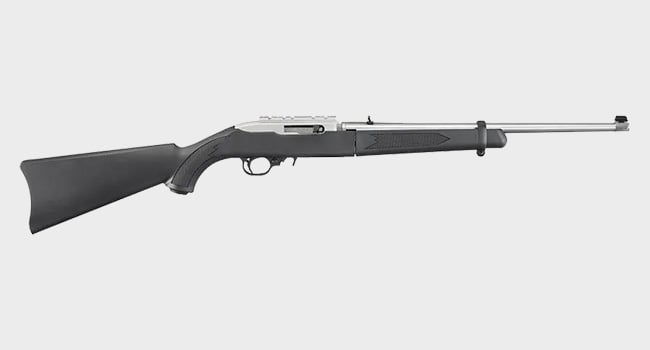
Caliber: .22LR
Capacity: 10
Action: Semi-auto blowback
Overall length: Varies by model
Barrel length: Varies by model
Weight: About 4.5 lbs
The 10/22 is one of Ruger's oldest and most popular designs. This 10-shot .22 can be disassembled and reassembled in seconds, and it's almost whisper-quiet, even without a suppressor. It comes factory standard with a scope base adapter that can accommodate both Weaver-style and tip-off scope mounts.
Remington 770
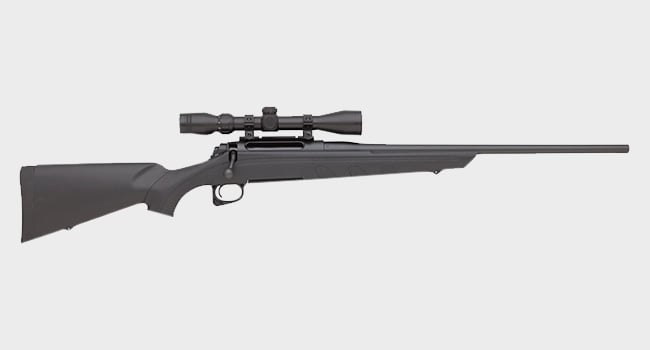
Caliber: .243 Winchester, .270 Winchester, 7mm-08 Remington, 7mm Remington Magnum, 30-06, .308, .300 Winchester Magnum
Capacity: 3 or 4, depending on caliber
Action: Bolt action
Overall length: 42.5 inches (non-Magnum) or 44.5 inches (Magnum)
Barrel length: 22 inches (non-Magnum) or 24 inches (Magnum)
Weight: 8.5 lbs
The 770 is one of Remington's most versatile and affordable bolt-action rifles. Its slow rate of fire and low capacity are significant concerns for a survival rifle, but aftermarket extended magazines are available. The 770 is an affordable survival rifle, and it can be a highly effective one, too, as long as you're a skilled long-range shooter with a backup weapon more suited to close-range encounters.
Savage Model 42 Takedown Compact

Caliber: .22LR and .410 shotgun
Capacity: 1/1
Action: Break-open
Overall length: 34.75 inches
Barrel length: 20 inches
Weight: 4.6 lbs
This .22 rifle does almost everything you could want: it's light, affordable, easy to break down and it boasts a .410 shotgun barrel for CQB self-defense or small game hunting. However, its meager two-round capacity is a significant drawback. If you want to use this rifle as your primary or only weapon, be sure to practice reloading until you can do so with lightning speed.
Chiappa M6
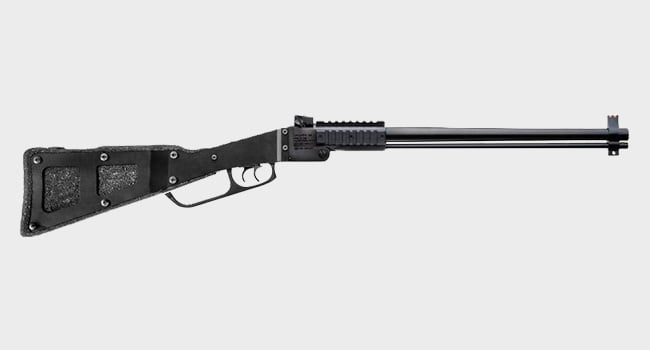
Caliber: .22LR or .22MWR (rifle barrel) and 12-gauge or 20-gauge (shotgun barrel)
Capacity: 1/1
Action: Break-open
Overall length: 34.6 inches
Barrel length: 18.5 inches
Weight: 5.8 lbs
The Chiappa M6 is essentially a beefier version of the Savage Model 42 Takedown Compact, but it's heavier and more expensive. 20 and 12-gauge shotgun shells boast significantly more stopping power than a .410, making them superior choices for self-defense at close range. As with the Model 42, you'll need to master the skill of quick reloads to mitigate the M6's single-shot capacity.
FoldAR Pistol
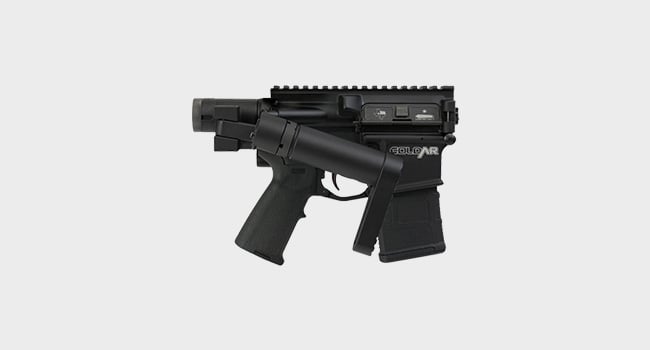
Caliber: 5.56, .223, or .300 Blackout
Capacity: 10, 20, or 30 (accepts most standard AR magazines)
Action: Semi-automatic gas-operated
Overall length: 30.25 inches (unfolded), 16.125 inches (folded)
Barrel length: 14.5 inches
Weight: 6.1 lbs
AR-15 rifles are popular and modular, but they can be bulky. FoldAR solves this problem with their foldable AR-15 that can quickly be reduced to half its normal size. Most models are quite expensive (upwards of $1,500), but a compact AR-15—especially one chambered in the relatively quiet .300 Blackout—can handle almost any survival situation you could think of.
Henry AR-7

Caliber: .22LR
Capacity: 8
Action: Semi-automatic blowback
Overall length: 35 inches
Barrel length: 16.125 inches
Weight: 3.5 lbs
The Henry AR-7 is one of the lightest .22 rifles on the market, making it a great choice if weight is a prime concern. With an MSRP of just $319, it's also easier on the wallet than any other .22 on this list. But again, .22LR is not a great self-defense round, so we recommend carrying the AR-7 along with a large-caliber sidearm.
AR-15 (Any Model)
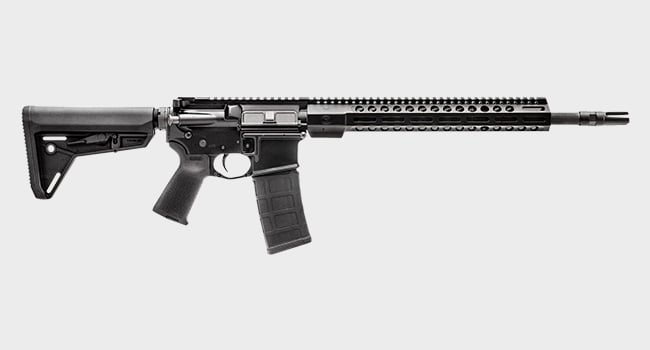
Caliber: Many calibers (5.56 and .223 are most common)
Capacity: Typically 10, 20, or 30
Action: Semi-automatic, various action types
Overall length: Approximately 30 inches
Barrel length: Usually 16 to 18 inches
Weight: Approximately 7 lbs
If the FoldAR would put too much strain on your budget, a normal AR-15 rifle could be the more affordable gun you're looking for. There are hundreds of models offered by dozens of manufacturers. Any of them can make highly versatile survival rifles, but they're loud, even with suppressors. They also aren't great for big game hunting, unless you get one chambered in .308 or another high-caliber round designed for that purpose.
Christensen Arms MPR

Caliber: .223, 6mm Creed, 6.5 PRC, 6.5 Creed, .308, .300 Winchester Magnum, .300 PRC, .338 Lapua Mag
Capacity: Varies by caliber
Action: Bolt-action
Overall length: 31.75 to 42.75 inches, depending on barrel length
Barrel length: 16 inches or 27 inches
Weight: 6.9 to 8.4 lbs
Got $2,500 to spend? Then consider the Christensen Arms MPR, sometimes regarded as the Cadillac of modern precision rifles. Its weight-to-precision ratio is truly impressive; many of its closest competitors weigh twice as much or more. The MPR also has a folding stock for increased portability and can be chambered in calibers equally suited to self-defense and big game hunting. However, it is a bolt-action rifle, so be sure to carry a sidearm (preferably a high-capacity, semi-automatic model).
As we've seen, survival rifles can vary widely in their capabilities, features, weight and price. You may prefer one that's good at everything but great at nothing, or you may want to double down on your rifle's strengths (which usually means covering its weaknesses by carrying at least one other weapon). Whichever way you decide to go, always train well and often for the specific kinds of survival situations you expect to encounter.
Did you find this article helpful?



